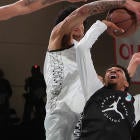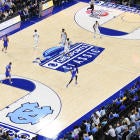
College basketball on the whole is getting better in the classroom and in keeping its players eligible. The proof is in the latest NCAA's report on its Academic Progress Rate (APR). The NCAA reports that the most recent figures -- the year ending with 2014-15, culminating the most recent four-year rate -- comes in at an all-time high of 979 across every sanctioned Division I sport. That's up from last year's four-year average mark of 978. (The highest possible mark is 1,000.)
Men's basketball, specifically, is up from 961 to 964 on average across the past four years. If you're curious, football sits at 959, also up three points from a year ago. Here's how men's hoops stacks up to the rest of D-I.
#NCAAhockey and #NCAAgym are tops in APR for both men and women. pic.twitter.com/IjnJB0bcxH
— NCAA Research (@NCAAResearch) April 20, 2016
The point of the APR is to try and keep schools honest, to keep players eligible and, in the process, reward them for doing so. By failing to reach the 930 four-year average, programs go on one-year postseason bans.
No FBS football programs face postseason bans. Five FCS teams will miss the postseason: Florida A&M, Howard, Morgan State, Savannah State and Southern.
Only two men's college basketball programs will meet that fate next year: Alcorn State and Savannah State.
This marks the first time since the APR was instituted, over a decade ago, that so few teams have received a postseason ban in college hoops.
The number was four teams a year ago. It sat at eight in 2014. It was six in 2013, and a whopping 10 the year before that. The most famous of all programs to ever suffer a postseason ban was UConn, which did so back in the 2012-13 season.
And remember, a few years ago, the bar was raised from 900 to 930. There are other programs who have received varying levels of violations for poor performance, but they still qualify for postseason play next season. Those schools are Florida A&M, Morehead State, Morgan State and North Carolina A&T.
The most encouraging news, on its surface, via the NCAA: "Also notable was the steady increase in scores earned by teams at limited-resource schools and historically black colleges and universities. The single-year APR for limited-resource schools increased from 945 to 966 in the last five years, while HBCUs saw an increase from 918 to 956 during that time."
Across all Division I sports, the number of ineligible teams for the postseason next year (23) is up from last year's number of 21. And the teams penalized in any form via APR protocol has risen to 31 from 28.
23 Division I teams will be ineligible for NCAA postseason competition next year due to low APR. pic.twitter.com/Bo0xDJxBx7
— NCAA Research (@NCAAResearch) April 20, 2016
If you'd like to see how any and every university and all of its D-I programs are performing in the APR, the NCAA hosts a searchable database right here. The APR is not a perfect system, and many of the criticisms against it are valid, but if the NCAA's ultimate goal was to keep schools from running off players and putting an emphasis on eligibility and graduation, then it's been a win to this point.
















